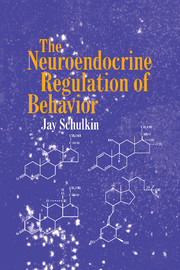Book contents
- Frontmatter
- Contents
- Acknowledgments
- Introduction
- 1 Hormones, Development, and Sexual Dimorphic Behaviors
- 2 Hormonal Regulation of Sodium and Water Ingestion
- 3 Hormonal Regulation of Food Selection
- 4 Hormones, Parental Care, and Attachment Behaviors
- 5 Hormonal Regulation of Fear and Stress
- 6 Hormones, Behavior, and Biological Clocks
- Conclusion
- References
- Name Index
- Subject Index
6 - Hormones, Behavior, and Biological Clocks
Published online by Cambridge University Press: 25 January 2011
- Frontmatter
- Contents
- Acknowledgments
- Introduction
- 1 Hormones, Development, and Sexual Dimorphic Behaviors
- 2 Hormonal Regulation of Sodium and Water Ingestion
- 3 Hormonal Regulation of Food Selection
- 4 Hormones, Parental Care, and Attachment Behaviors
- 5 Hormonal Regulation of Fear and Stress
- 6 Hormones, Behavior, and Biological Clocks
- Conclusion
- References
- Name Index
- Subject Index
Summary
Introduction
One of evolution's most successful adaptations is the self-generated rhythmicity (endogenous rhythmicity) with which organisms adjust to periodic influences in their environments, including diurnal, lunar, seasonal, and tidal cycles. By measuring the passage of time, endogenous biological clocks regulate both behavior and physiology, with one complementing the other. There are several kinds of biological clocks, and their anatomic locations and functions vary across species.
In most species, a behavior alternates between an active phase and a restful phase. Recall that during active periods the concentrations of hormones such as cortisol are elevated. The active phase reflects energy use, and the rest phase energy conservation. However, hormones such as melatonin, which is secreted at night, can be elevated during the active phase or the rest phase, depending upon the presence of light/darkness. In rodents, two oscillators have been hypothesized: One oscillator is synchronized to dusk, and the other to dawn, and the two are entrained to one another (e.g., Pittendrigh and Daan, 1976).
In most animal species, sleep is regulated both by circadian (daily) mechanisms and by mechanisms that maintain homeostasis. One mechanism monitors time, while the other monitors the need for sleep. In some cases the circadian clock may facilitate wakefulness against the opposing homeostatic need to remain asleep (Edgar et al., 1992). Sleep deprivation acts on the homeostatic mechanisms for sleep; within limits, the more sleep an animal loses, the more it will need to make up.
- Type
- Chapter
- Information
- The Neuroendocrine Regulation of Behavior , pp. 180 - 213Publisher: Cambridge University PressPrint publication year: 1998



